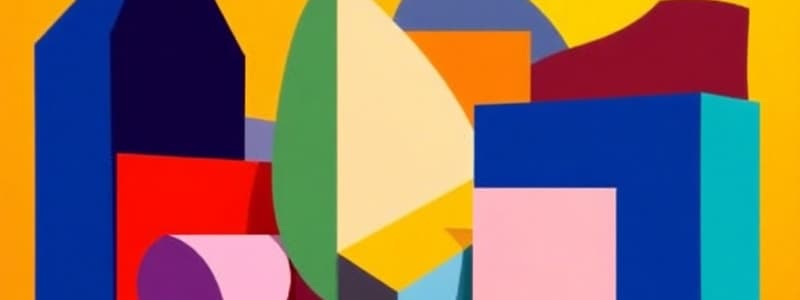Podcast
Questions and Answers
Which solid figure has two parallel, congruent circular bases and curved sides?
Which solid figure has two parallel, congruent circular bases and curved sides?
- Prism
- Cone
- Sphere
- Cylinder (correct)
What is the defining feature of a pyramid?
What is the defining feature of a pyramid?
- A single vertex and triangular faces (correct)
- All points equidistant from the center
- Curved sides and circular bases
- Two parallel, congruent bases
Which of the following is NOT a key feature of prisms?
Which of the following is NOT a key feature of prisms?
- Parallel bases
- Two congruent bases
- Sides are parallelograms
- A single vertex (correct)
Which solid figure is described as having all points equidistant from the center?
Which solid figure is described as having all points equidistant from the center?
A box is an example of which solid figure?
A box is an example of which solid figure?
What is the name of a pyramid with a square base?
What is the name of a pyramid with a square base?
What is the name of a two-dimensional pattern that can be folded to create a three-dimensional solid figure?
What is the name of a two-dimensional pattern that can be folded to create a three-dimensional solid figure?
What are the flat surfaces of a solid figure called?
What are the flat surfaces of a solid figure called?
Flashcards
Solid Figures
Solid Figures
Three-dimensional shapes that occupy space with length, width, and height.
Prisms
Prisms
Solid figures with two parallel, congruent bases that are polygons; sides are parallelograms.
Cylinders
Cylinders
Solid figures with two parallel, congruent circular bases and curved sides.
Cones
Cones
Signup and view all the flashcards
Spheres
Spheres
Signup and view all the flashcards
Pyramids
Pyramids
Signup and view all the flashcards
Faces, Edges, and Vertices
Faces, Edges, and Vertices
Signup and view all the flashcards
Nets of Solid Figures
Nets of Solid Figures
Signup and view all the flashcards
Study Notes
Solid Figures: Visualizing and Describing
-
Solid figures are three-dimensional shapes. They occupy space and have length, width, and height.
-
Different solid figures have unique characteristics:
- Prisms: These figures have two parallel, congruent polygonal bases. The sides are parallelograms connecting the bases.
- Examples include rectangular prisms (boxes), triangular prisms (like leaning tents), and pentagonal prisms.
- Key feature: Parallel bases; sides are parallelograms.
- Cylinders: These figures have two parallel, congruent circular bases. The sides are curved, like a can.
- Key feature: Circular bases, curved sides.
- Cones: These figures have a circular base and a single vertex (point) connecting to the center of the circular base.
- Key feature: Circular base, single vertex.
- Spheres: These figures are perfectly round. All points are equidistant from the center.
- Key feature: All points equidistant from the center.
- Pyramids: These figures have a polygonal base and triangular faces that meet at a single vertex (point). The triangular faces connect to the base.
- Key feature: Polygonal base, triangular faces meeting at a single vertex.
- Examples include square pyramids, triangular pyramids, and pentagonal pyramids; the base shape names the pyramid.
- Prisms: These figures have two parallel, congruent polygonal bases. The sides are parallelograms connecting the bases.
-
Faces, Edges, and Vertices:
- Every solid figure consists of these elements.
- Faces: The flat surfaces of the solid figure.
- Edges: Lines formed where two faces meet.
- Vertices: Points where three or more edges meet.
Identifying Solid Figures
- Identify solid figures in everyday objects:
- Boxes are rectangular prisms.
- Cans are cylinders.
- Ice cream cones are cones.
- Balls are spheres.
- Pyramids are present in some monuments.
Describing Solid Figures
- Use precise terminology when describing solid figures. Avoid vague descriptions. For instance, instead of "a three-sided pointy thing," use "triangular pyramid with a triangular base".
Properties of Solid Figures
- When describing a solid figure, note its:
- Number of faces
- Number of edges
- Number of vertices
- Shape of the base (if applicable).
Nets of Solid Figures
- A net is a two-dimensional pattern that folds into a three-dimensional solid shape.
- Nets visualize the faces of a solid form.
- Nets show how flat surfaces combine into a 3D shape.
- Example: A net for a cube has six squares.
Real-World Examples of Solid Figures
- Identify solid figures in your surroundings beyond classroom examples.
- Many practical solid shapes are found in your home.
Visual Activities
- Observe solid figures in the classroom and your environment.
- Draw various solid figures.
- Construct solid figures from nets or using manipulatives.
Classifying Solid Figures
- Categorize solid figures based on their shared properties to develop strong mental models of these 3D shapes.
Studying That Suits You
Use AI to generate personalized quizzes and flashcards to suit your learning preferences.
Description
Explore the world of solid figures in this quiz, focusing on three-dimensional shapes that occupy space and have length, width, and height. Delve into the unique characteristics of prisms, cylinders, cones, and spheres. Challenge your understanding of these geometric forms and their properties.




